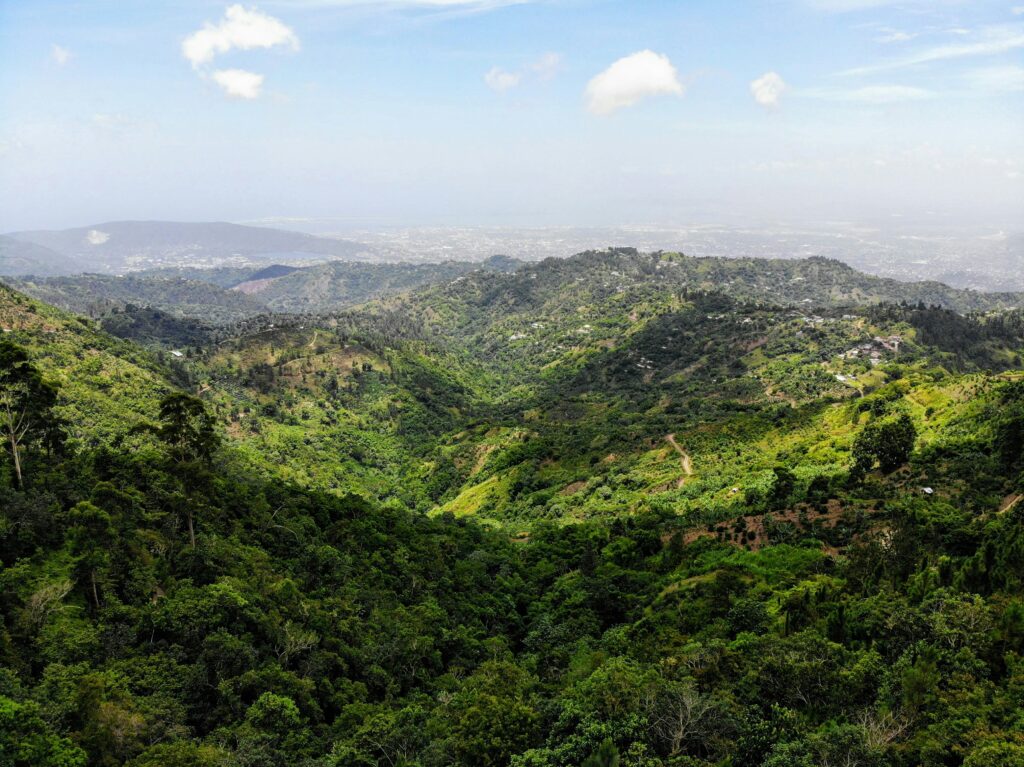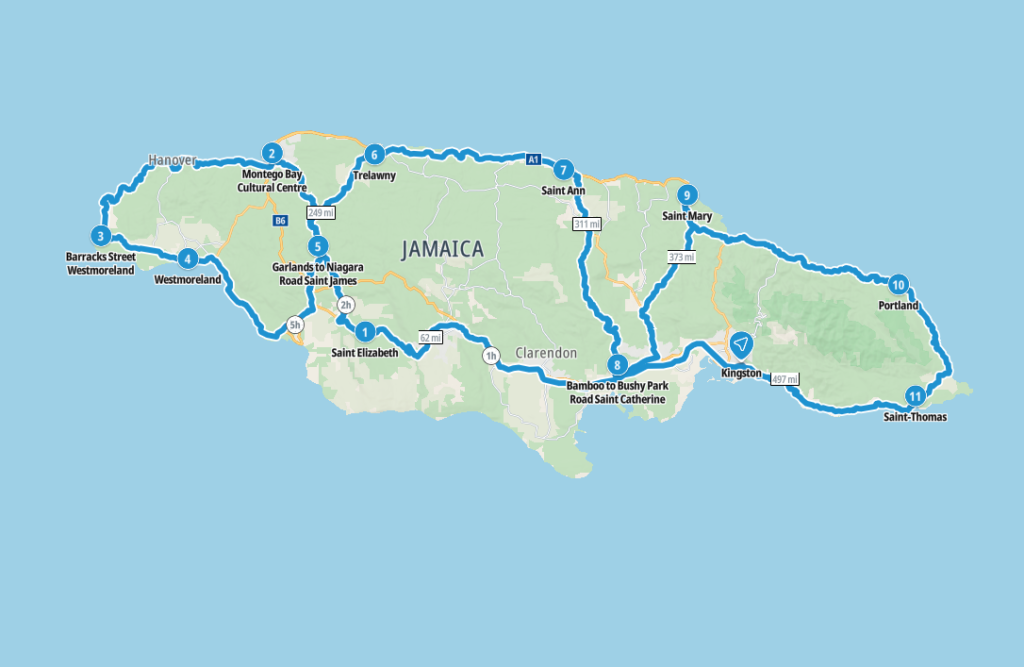Jamaica / Jumieka – Let’s explore here
What’s it like in Jamaica?
Jamaica is the third largest island in the Caribbean Sea in North America. It is 146 miles (235 km) long and maximum 52 miles (84 km) in width. It also consists of around 49 much smaller islands.
The island mostly consists of mountainous areas, and the highest point is Blue Mountain Peak, at 7.402 ft (2.256m) above sea level.
Jamaica’s population is around 2.8 million (2019), about two in five of whom live in the capital, Kingston. Jamaica relies heavily on tourism as a major source of income, and an estimated 4.3 million (2019) tourists visit Jamaica every year. Jamaica was also the birthplace of Rastafarianism and reggae music.

A bit about the history of Jamaica
Pre Columbian Jamaica
Before the arrival of Europeans, Jamaica was inhabited by the Arawak and Taíno peoples, who are believed to have migrated to the island around 600 AD. The Taíno people lived in small villages and cultivated crops such as cassava, maize and tobacco. They were skilled in fishing and had a rich culture, including art, music and religious practices. They referred to the island as ‘Xaymaca’, which translates to ‘Land of Wood and Water’.
European Discovery and Spanish Colonisation
In 1494, Christopher Columbus arrived in Jamaica during his second voyage to the Americas. The island was claimed by Spain, and the Taíno population was soon decimated by European diseases, forced labour and violence. The Spanish established settlements, but Jamaica was of limited economic importance to Spain. Over time, they abandoned much of the island, leaving it sparsely populated.
English Conquest and Colonisation
In 1655, the English captured Jamaica from the Spanish in the Battle of Ocho Rios. This marked the beginning of English rule over the island. The English developed Jamaica as a sugar-producing colony, and the island’s economy was heavily reliant on enslaved Africans brought over to work on sugar plantations. By the 18th century, Jamaica had become one of the largest producers of sugar in the Caribbean.
The Transatlantic Slave Trade
The demand for labour on the sugar plantations led to the forced importation of thousands of enslaved Africans. Between the 17th and 19th centuries, Jamaica became a major centre for the transatlantic slave trade. The enslaved people were subjected to brutal conditions on the plantations, but many managed to maintain aspects of their African culture, blending it with the island’s indigenous and European influences.
Maroon Societies and Rebellions
Throughout the 17th and 18th centuries, enslaved Africans who escaped from the plantations formed independent communities in the mountainous interior of Jamaica. These groups, known as the Maroons, resisted English control and successfully fought several wars against the British. In 1739, the British signed a peace treaty with the Maroons, granting them autonomy in exchange for their agreement to stop supporting runaway slaves. Jamaica also saw several slave rebellions, the most famous being the 1831 Baptist War, led by Samuel Sharpe. This rebellion played a significant role in the movement to abolish slavery on the island.
Abolition of Slavery and Social Change
Slavery was officially abolished in Jamaica in 1834, following the passage of the Slavery Abolition Act in the British Empire. The end of slavery did not lead to immediate improvement for the newly freed people, however. Many former slaves were forced into conditions of poverty and exploitation as they struggled to find work on the plantations. Over the following decades, social and political tensions continued to grow, leading to labour unrest and protests for better working conditions and civil rights.
Post-Emancipation and Economic Challenges
Following emancipation, Jamaica continued to rely heavily on agriculture, particularly sugar and bananas, but faced economic challenges due to changing global markets and the decline of the sugar industry. The country also experienced political instability, with power concentrated in the hands of a few wealthy landowners, many of whom were of European descent. Throughout the late 19th and early 20th centuries, movements for labour rights, political representation, and social change began to take root.
The Path to Independence
Jamaica gained self governance in 1944 with the introduction of universal adult suffrage. In 1961, the island was faced with the decision to remain part of the British Empire or seek full independence. After a referendum, Jamaica chose independence, and on 6 August 1962, the country officially became a sovereign nation. Sir Alexander Bustamante became Jamaica’s first prime minister.
Political and Social Development
Following independence, Jamaica went through various phases of political change, with the two main political parties, the Jamaica Labour Party (JLP) and the People’s National Party (PNP), alternating in power. The 1970s saw a period of significant social reform under Prime Minister Michael Manley, particularly in areas such as education and health care. However, political violence and economic difficulties also marked this era.
Economic and Social Challenges
In the decades after independence, Jamaica faced economic challenges, particularly related to its dependence on agriculture and tourism. The country struggled with inflation, unemployment and debt. Economic difficulties were compounded by crime, poverty and a growing drug trade. Despite these challenges, Jamaica became known for its cultural contributions, particularly in music. The emergence of reggae music, with artists like Bob Marley, made a significant impact on global music culture.
Modern Jamaica
Today, Jamaica is a vibrant, independent nation with a rich cultural legacy. While it has made significant progress in some areas, such as tourism, education and sports, the country still faces issues related to crime, poverty and economic inequality. Nevertheless, Jamaica’s global influence in music, particularly reggae, as well as its reputation for sporting excellence, particularly in athletics, continues to bring international attention to the island.

Jamaica road trip
Haiti is our 28th planned stop on our road trip through the islands of the Caribbean. Having explored the the Cayman Islands, our next stop is Cuba.
Travelling overland between the islands is quite prohibitive due to the lack of transportation options. Travelling between different island countries via ferry is possible, however, ferries only operate between some islands. Chartering private boats between islands is also possible, although travelling with a car in this way is prohibitive. Flying is another option, although again, flights only operate between some islands.
Map of our Jamaican road trip

This is a map of our planned route around Jamaica, starting and ending at the capital city, Kingston.
Weather in Jamaica
When is the best time to visit Jamaica?
The best time to visit Jamaica is from January to April. During these months, the island has 8 – 9 hours of sunshine per day and rainfall of 0.3 – 3.0 inches (9 – 77mm) per month. The temperature ranges from 22 – 32°C (72 – 89°F).
When is the worst time to visit Jamaica?
The worst time to visit Jamaica is from May to November. During these months, the island still has 7 – 8 hours of sunshine per day, however, humidity rises and it rains an average of 2.2 – 7.3 inches (56 – 185mm) per month. The temperature ranges from 24 – 33°C (75 – 92°F).
Hurricane Season in the Caribbean
Hurricane season in the Caribbean runs from June 1 to November 30. Storms tend to be more frequent and more severe in the latter half of the season.
Hurricanes are least likely during December, January and February.
Travel in and around Jamaica
Ferries to other Caribbean island countries from Jamaica
There are no ferries from Jamaica to other countries
What’s it like to drive in Jamaica?
They drive on the right hand side of the road in Jamaica. A Carnet de Passages is required to overland in Jamaica.
Car hire is available in Jamaica and roads are, in the main, quite good. There are minor roads inland and to bays and coves however that are not maintained and in very poor condition.
We’ve also created a dedicated page to driving abroad, which you might find helpful 🙂
What currency do they use in Jamaica?
In Jamaica they use the Jamaican dollar. Cash is widely used. The use of credit / debit cards is widely accepted in major cities, although not in rural areas. Travellers cheques are not accepted in the main. There are ATMs in cities, although not all accept foreign issued cards.
You should make yourself aware of the amount that your bank charges you for using credit and debit cards abroad. Often credit cards are cheaper for purchasing items directly, and for withdrawing cash from ATMs.
What language do they speak in Jamaica?
They speak English and Jamaican Patois in Jamaica. English is spoken in tourist areas.
What time zone is Jamaica in?
Remember, when you’re planning your next trip to take a look at what time zone it’s in.
Do I need a visa to visit Jamaica?
We’ve created a dedicated, more comprehensive page on visas, which you should find helpful. Check it out!
Is wild camping legal in Jamaica?
No, wild camping is not widely accepted in Jamaica.
What plug / socket type do they use in Jamaica?
In Jamaica they use plug / socket types A and B.


Health issues in Jamaica
Is it safe to drink water in the Jamaica?
No, it is not safe to drink tap water in Jamaica. Bottled water is readily available across the country.
What vaccinations are required for Jamaica?
This NHS website is kept up to date with all relevant information on vaccinations in Jamaica.
Phones in Jamaica
What is the country calling code for Jamaica?
The country calling codes for Jamaica are +1 658 and +1 876
What are the emergency phone numbers in Jamaica?
- The emergency number for police in Jamaica is: 119
- In Jamaica, the emergency number for ambulance is: 110
- The emergency number for fire in Jamaica is: 110
If you’ve got some useful info that you’d like to share, let us know!
And don’t forget to check out all the other pictures!
